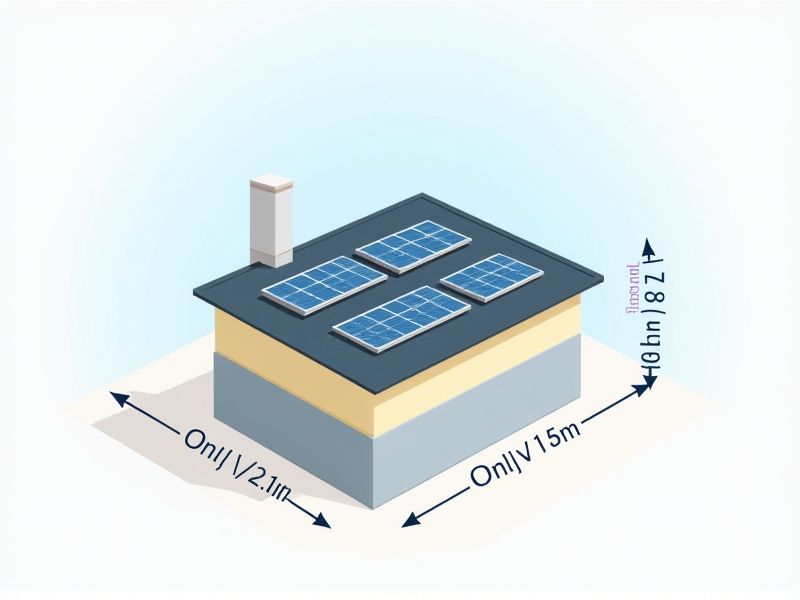
Rooftop solar panels typically come in standardized sizes to simplify installation and compatibility. Most residential solar panels are approximately 65 inches by 39 inches (about 5.4 feet by 3.25 feet) in dimension, and they weigh between 40 to 50 pounds. Commercial panels are usually slightly larger, measuring around 77 inches by 39 inches. When planning your installation, knowing these standard dimensions helps you estimate how many panels will fit on your roof and determine your potential energy production.
Dimensions: Typical Size Approximately 65 X 39 Inches.
The standard dimensions for rooftop solar panels are approximately 65 inches in length and 39 inches in width, providing a space-efficient solution for residential and commercial rooftops. Each panel typically has a power output ranging from 250 to 400 watts, suited for various energy needs. With an average efficiency rate of 15% to 22%, these panels convert sunlight into electricity effectively. Understanding these specifications can help you maximize your solar energy system's performance and overall energy savings.
Thickness: Around 1.25 To 2 Inches.
Rooftop solar panels typically have a thickness ranging from 1.25 to 2 inches, which plays a critical role in their installation and efficiency. This thickness allows for optimal structural integrity while ensuring that the panels can effectively absorb sunlight. Solar panel systems can vary in weight, averaging between 40 to 50 pounds per panel, making their thickness crucial for adequate support. When considering installation, it's essential to assess your roof's ability to accommodate this thickness without compromising stability.
Weight: Ranges From 40 To 50 Pounds.
Rooftop solar panels typically weigh between 40 to 50 pounds each, which significantly impacts structural considerations for installation. This weight range ensures that the panels are durable yet manageable for residential rooftops without compromising integrity. When planning your installation, it's crucial to assess the bearing capacity of your roof, especially if multiple panels are used. Ensuring a secure and compliant setup not only enhances efficiency but also extends the lifespan of your solar energy system.
Efficiency: Higher Efficiency Panels May Have Slightly Different Dimensions.
Rooftop solar panels typically vary in efficiency, with high-efficiency models exceeding 20% conversion rates. These premium panels, while more effective at converting sunlight to electricity, often range in size from 60 to 72 cells, influencing their overall dimensions. For homeowners, selecting panels with a higher efficiency can significantly reduce the space required for installation while maximizing energy output. Investing in top-tier solar technology can yield substantial long-term savings on your electricity bills and contribute to a more sustainable energy solution.
Cell Count: Usually Comprises 60 To 72 Solar Cells.
Rooftop solar panels typically consist of either 60 or 72 solar cells, with each cell playing a crucial role in harnessing solar energy. A standard 60-cell panel generally produces around 250 to 350 watts, making it suitable for smaller residential setups. In contrast, 72-cell panels can generate between 350 and 450 watts, ideal for larger homes or commercial installations. When choosing your solar panel, consider the cell count as it directly influences the panel's efficiency and energy output.
Material: Often Made From Monocrystalline Or Polycrystalline Silicon.
Rooftop solar panels primarily utilize two types of silicon materials: monocrystalline and polycrystalline. Monocrystalline panels are known for their high efficiency rates, often exceeding 20%, and they benefit from a sleek appearance due to their uniform black coloring. In contrast, polycrystalline panels, typically found at a lower price point, achieve efficiency rates between 15% and 20%, featuring a blue speckled look resulting from the manufacturing process. Selecting the right material can significantly impact your energy production, installation costs, and overall aesthetics.
Power Output: Generally Ranges Between 250 To 400 Watts.
Rooftop solar panels typically generate power outputs ranging from 250 to 400 watts, catering to various energy needs. Choosing a panel with a higher wattage can significantly enhance your home's energy efficiency and reduce electricity bills. The efficiency of these panels is influenced by factors such as sunlight exposure and installation angle. For optimal performance, consider panels that offer warranties exceeding 25 years, ensuring reliability and long-term savings.
Frame: Anodized Aluminum Frame For Durability.
The anodized aluminum frame of rooftop solar panels is engineered for exceptional durability and resistance to environmental stressors, ensuring a longer lifespan. This material provides superior protection against corrosion, making it ideal for a variety of climates, whether hot, humid, or cold. Typically, these frames weigh around 10-15% of the overall panel weight, allowing for efficient installation without compromising the structural integrity of rooftops. A robust frame not only safeguards the solar cells but also contributes to the overall efficiency and performance of your solar energy system.
Installation: Standardized Sizes Facilitate Easier Installation And Fitting.
Rooftop solar panels are typically standardized in size, commonly measuring around 65 inches by 39 inches, which simplifies the installation process. This uniformity not only allows for efficient fitting onto various types of roofs but also streamlines installation times, often reducing labor costs by up to 30%. Moreover, standardized panels enhance compatibility with mounting systems, which can further optimize your solar energy output. Easy installation means quicker returns on investment, often averaging a payback period of 5 to 7 years, depending on local energy costs.
Compatibility: Designed To Fit Standard Rooftop Mounting Systems.
Rooftop solar panels are engineered for compatibility with standard mounting systems, ensuring seamless installation on residential and commercial buildings. Most panels measure approximately 65 inches by 39 inches and weigh around 40 pounds, making them suitable for various roof types. The integration of these solar panels can yield energy savings of up to 80% on your electricity bills, depending on sunlight exposure and local energy rates. Each panel typically has a lifespan of 25 years, providing long-term benefits and reliability for energy production.
